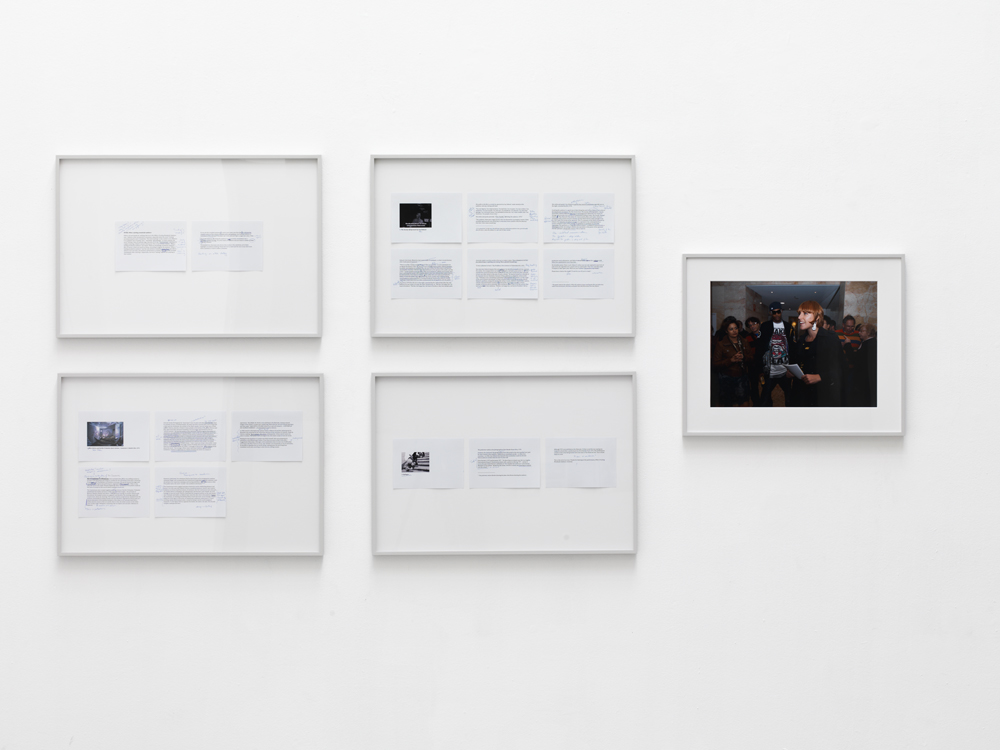Death at a 30 Degree Angle
2012 - Film & Video (Film & Video)
14:59 minutes
Bani Abidi
The perceived effortlessness of power, projecting above experiences of labored subordination is examined in Death at a 30 Degree Angle by Bani Abidi, which funnels this projection of image through the studio of Ram Sutar, renowned in India for his monumental statues of political figures, generally from the post-independence generation. In a contemporary Indian society beholden by strongmen, Abidi uses Sutar’s studio to fictionalize a sculptor producing commemorative works for populist, preening figures, surrounded by the likenesses of idolized politicians of the post-colony. Abidi’s video presents one such aspirational bureaucrat, trailed by a cadre of lackeys who fawn over the varying statues that are laboriously carted out for his approval. Never satisfied with his depiction, he works his way through a variety of increasingly ridiculous poses, the work a biting critique of the infallible facade produced through monumental imaging. Using the active mechanisms which concretize the reification of political figures, Death at a 30 Degree Angle intimately dissects the nationalist construction of political identity in India, to reveal the labor and profound inanity that lies beneath. All the while, scattered prototypes of Gandhi take in the bluster of the politician and the chaotic action of the shop assistants, invoking Gandhi’s own humanist reputation and famous image as aspirational. A complex doubling specter emerges over the actions of the politician, registering larger questions about India’s increasingly populist turn in juxtaposition with the lionization of early figures in the independent nation, which was notably marred by ethnic violence. Set in an uncertain state of action, Death at a 30 Degree Angle paints a scathing, cautious picture of the visual rhetoric of contemporary Indian politics. Death at a 30 Degree Angle mobilizes the searingly critical direct address that motivates portions of Abidi’s work. In its fictionalized account that dramatizes a disturbingly probable event, it radiates uncertainty about the efficacy and direction of apparatuses of power and control in India. Focused on an overtly political resonance, Death at a 30 Degree Angle highlights the emphasis on transformative, critical approaches to potentiality that her work has recently employed to grapple with politics, inequalities, and cultural differences in South Asia.
Bani Abidi’s practice deals heavily with political and cultural relations between India and Pakistan; she has a personal interest in this, as she lives and works in both New Delhi and Karachi. The artist’s subject matter ranges from border tensions to immigration conflicts, cultural diversity, and the relationship between private and public space. She works in the media of video, photography, and drawing.
Colors:
Related artist(s) to: Bani Abidi » Shilpa Gupta, » Adel Abdessemed, » Adrian Paci, » Dan Perjovschi, » Dora Garcia, » Eko Nugroho, » Hou Hanru, » Oliver Ressler, » Pedro Reyes, » San Francisco

© » KADIST
Dora Garcia
2012KLAU MICH is a TV and performance project by Dora García with Ellen Blumenstein, Samir Kandil, Jan Mech, TheaterChaosium, and Offener Kanal Kassel, during the 100 days of dOCUMENTA (13)....

© » KADIST
Eko Nugroho
2009Nugroho’s installations and performances have their roots in the shadow puppet rituals in Indonesia, particularly the Javanese Wayang tradition whose essence is in the representation of the shadows...

© » KADIST
Dora Garcia
2008Dora Garcia’s work is a result of institutional critique and more generally that of language, following the conceptual artists of the 1960s like Weiner and Kosuth and Fraser from the 1980s and 1990s...

© » KADIST
Shilpa Gupta
2009In Untitled (Sword) , addressing histories of colonialism with abstraction, a large steel blade extends from the gallery wall...

© » KADIST
Shilpa Gupta
2014These hand drawn maps are part of an ongoing series begun in 2008 in which Gupta asks ordinary people to sketch outlines of their home countries by memory...

© » KADIST
Shilpa Gupta
2014These hand drawn maps are part of an ongoing series begun in 2008 in which Gupta asks ordinary people to sketch outlines of their home countries by memory...

© » KADIST
Pedro Reyes
2012Pedro Reyes’s Los Mutantes ( Mutants , 2012) is composed of 170 plates that combine characters from ancient and modern mythologies...

© » KADIST
Shilpa Gupta
2008The three monkeys in Don’t See, Don’t Hear, Don’t Speak are a recurring motif in Gupta’s work and refer to the Japanese pictorial maxim of the “three wise monkeys” in which Mizaru covers his eyes to “see no evil,” Kikazaru covers his ears to “hear no evil,” and Iwazaru covers his mouth to “speak no evil.” For the various performative and photographic works that continue this investigation and critique of the political environment, Gupta stages children and adults holding their own or each other’s eyes, mouths and ears...

© » KADIST
Pedro Reyes
2005In Reyes’s words, “We should be able to extract the technological nutrients before we excrete our waste...



